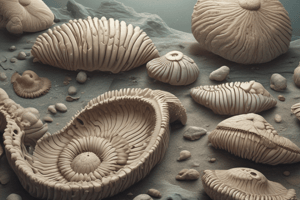Podcast
Questions and Answers
What feature indicates the growth of the shell from its embryonic origin?
What feature indicates the growth of the shell from its embryonic origin?
- Pedicle
- Concentric growth lines (correct)
- Radial ribs
- Costae
In which classification is the Order Lingulida categorized?
In which classification is the Order Lingulida categorized?
- Articulates
- Inarticulates (correct)
- Astrophic
- Strophic
Which subphylum includes brachiopods that are known to be circular to subcircular in shape?
Which subphylum includes brachiopods that are known to be circular to subcircular in shape?
- Craniiformea (correct)
- Rhynchonelliformea
- Linguliformea
- Anthropoda
What characterizes the brachiopods of Order Athyridida?
What characterizes the brachiopods of Order Athyridida?
What material primarily composes the shells of inarticulates?
What material primarily composes the shells of inarticulates?
Which subphylum is best known for the genus Lingula?
Which subphylum is best known for the genus Lingula?
The extraordinary longevity of Lingula is attributed to its ability to live in what type of habitat?
The extraordinary longevity of Lingula is attributed to its ability to live in what type of habitat?
What is a distinguishing feature of articulate brachiopod shells?
What is a distinguishing feature of articulate brachiopod shells?
What characteristic feature distinguishes the suborder Spiriferidina within the order Spiriferida?
What characteristic feature distinguishes the suborder Spiriferidina within the order Spiriferida?
How do strophomenides typically differ in shell shape compared to other brachiopod orders?
How do strophomenides typically differ in shell shape compared to other brachiopod orders?
Which of the following features are common to the order Terebratulida?
Which of the following features are common to the order Terebratulida?
What ecological role do brachiopods primarily fulfill in marine environments?
What ecological role do brachiopods primarily fulfill in marine environments?
Which of the following describes the primary habitat requirements for brachiopods?
Which of the following describes the primary habitat requirements for brachiopods?
What primary feature typically differentiates brachiopods from bivalves?
What primary feature typically differentiates brachiopods from bivalves?
Which brachiopod group is characterized by having a completely closed pedicle foramen?
Which brachiopod group is characterized by having a completely closed pedicle foramen?
What is a key morphological feature of the shell structure in Terebratulina septentrionalis?
What is a key morphological feature of the shell structure in Terebratulina septentrionalis?
What is the function of the lophophore in brachiopods?
What is the function of the lophophore in brachiopods?
Which subphylum of Brachiopoda includes the group known as lingulids?
Which subphylum of Brachiopoda includes the group known as lingulids?
How does the morphology of modern brachiopods differ from Palaeozoic brachiopods?
How does the morphology of modern brachiopods differ from Palaeozoic brachiopods?
What are the two types of valves in a typical brachiopod shell?
What are the two types of valves in a typical brachiopod shell?
What role do setae play in the brachiopod's anatomy?
What role do setae play in the brachiopod's anatomy?
In which geological period did brachiopods first originate?
In which geological period did brachiopods first originate?
What is the primary feeding strategy of brachiopods?
What is the primary feeding strategy of brachiopods?
What does the term 'living fossils' refer to in the context of brachiopods?
What does the term 'living fossils' refer to in the context of brachiopods?
Flashcards
Brachiopod Inarticulates
Brachiopod Inarticulates
Brachiopods with shells lacking defined hinges, made of calcium phosphate, and relying on muscles for movement.
Brachiopod Articulates
Brachiopod Articulates
Brachiopods with articulated hinges (teeth and sockets), made of calcium carbonate.
Linguliformea
Linguliformea
A subphylum of brachiopods characterized by shells lacking defined hinges.
Order Lingulida
Order Lingulida
Signup and view all the flashcards
Rhynchonelliformea
Rhynchonelliformea
Signup and view all the flashcards
Craniiformea
Craniiformea
Signup and view all the flashcards
Brachiopod Costae
Brachiopod Costae
Signup and view all the flashcards
Lingula
Lingula
Signup and view all the flashcards
Brachiopod Habitat
Brachiopod Habitat
Signup and view all the flashcards
Brachiopod Shell Shape
Brachiopod Shell Shape
Signup and view all the flashcards
Brachiopod Morphology - Lophophore
Brachiopod Morphology - Lophophore
Signup and view all the flashcards
Brachiopod Morphology - Coelomic Cavity
Brachiopod Morphology - Coelomic Cavity
Signup and view all the flashcards
Brachiopod Morphology - Nephridium
Brachiopod Morphology - Nephridium
Signup and view all the flashcards
Brachiopod Morphology - Setae
Brachiopod Morphology - Setae
Signup and view all the flashcards
Brachiopod Morphology - Adductors
Brachiopod Morphology - Adductors
Signup and view all the flashcards
Brachiopod Diversity
Brachiopod Diversity
Signup and view all the flashcards
Spiriferida Order
Spiriferida Order
Signup and view all the flashcards
Spiriferidina Suborder
Spiriferidina Suborder
Signup and view all the flashcards
Strophomenida Order
Strophomenida Order
Signup and view all the flashcards
Strophomenidina Suborder
Strophomenidina Suborder
Signup and view all the flashcards
Terebratulida Order
Terebratulida Order
Signup and view all the flashcards
Brachiopod Ecology
Brachiopod Ecology
Signup and view all the flashcards
Brachiopod vs. Bivalve
Brachiopod vs. Bivalve
Signup and view all the flashcards
Study Notes
Phylum Brachiopoda
- Brachiopods were dominant shelly marine invertebrates during the Paleozoic Era.
- They originated in the early Cambrian and diversified in the Ordovician.
- They survived the end-Permian mass extinction but declined through the Mesozoic.
- Classified into three subphyla: Linguliformea, Craniiformea, and Rhynchonelliformea.
- Exclusively marine filter feeders.
- Shell shape can indicate the substrate type.
- Communities can be used to study paleoenvironments.
- Some, like lingulids, have remained unchanged for 500 million years, called living fossils.
- Terebratulides are sometimes called lamp shells due to their resemblance to oil lamps.
- Most modern brachiopods live in marginal marine environments and have similar morphologies.
- Paleozoic brachiopods had a wider range of morphologies, from erect coral-like forms to flattened saucer shapes.
Morphology
- Brachiopod shells have one larger valve (ventral or pedicle valve).
- The ventral valve has an opening for a pedicle stalk to attach to the substrate.
- The opposite smaller valve is the dorsal (or brachial) valve.
- Lophophore (brachium) attaches to the dorsal valve, filling most of the interior.
- Coelomic cavity houses internal organs.
- Metanephridium (kidney-like structure) for waste excretion exists.
- Setae (bristles) around the margin sense the environment.
- Adductor muscles (connected to dorsal and ventral valves) close the shell.
- Diductor muscles are connected to the ventral valve pulling and opening,
- Pedicle foramen is the opening for the pedicle.
- Delthyrium is a notch in the ventral valve (rather than foramen in some cases).
- Notothyrium is a notch in the dorsal valve.
Morphology (additional)
- Pedicle foramen (opening for the pedicle) is often in the beak.
- Deltidial plates or a single deltidium may enclose the foramen.
- Delthyrium is a shallow notch instead of a foramen.
- Chilidium may be a plate enclosing the notothyrium.
- Pentameride brachiopods have a spondylium (spoon-shaped platform) in the ventral valve.
- Cruralium (spoon-shaped feature) is in the dorsal valve.
- Septum subdivides the shell into chambers.
Phylum Brachiopoda: Classification
- Traditional Classification:
- Inarticulates: calcium phosphate shells, no hinges or teeth, held together by muscles, (e.g., Lingulida).
- Articulates: calcium carbonate shells with hinges and teeth, (all other brachiopods).
- Modern Classification:
- Subphyla include Linguliformea, Rhynchonelliformea, and Craniiformea.
Ecology and Paleoecology
- Benthic marine animals.
- Filter feeders; do not actively search for food; rely on currents for food/oxygen and waste removal.
- Life styles include burrowing, semi-infaunal, epifaunal, and encrusting.
Distinguishing Brachiopods and Bivalves
- Superficial similarities but different symmetry plane.
- Bivalves have left and right valves aligned with the line of symmetry along the valves' edges.
- Brachiopods have dorsal and ventral valves with the line of symmetry dividing each valve in half.
- Most brachiopods have a plane of symmetry that runs through both shells; the right valve is a mirror image of the left in bivalves.
Studying That Suits You
Use AI to generate personalized quizzes and flashcards to suit your learning preferences.




